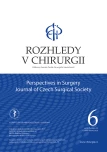-
Medical journals
- Career
Laparoscopic inguinal hernia repair in children via PIRS (percutaneous internal ring suturing)
Authors: B. Frýbová 1; J. Trčka 1; V. Dotlačil 1; L. Poš 1; D. Patkowski 2; M. Rygl 1
Authors‘ workplace: Klinika dětské chirurgie 2. lékařské fakulty Univerzity Karlovy a Fakultní nemocnice v Motole 1; Department of Pediatric Surgery and Urology, Medical University, Wroclaw 2
Published in: Rozhl. Chir., 2020, roč. 99, č. 6, s. 277-281.
Category: Original articles
doi: https://doi.org/10.33699/PIS.2020.99.6.277–281Overview
Introduction: The miniinvasive approach is a trend in pediatric surgery nowadays. The new surgical technique called percutaneous internal ring suturing (PIRS) is a promising method bringing all the benefits of miniinvasive surgery.
Methods: Prospective study of patients operated on using the PIRS technique from 01 January 2018 to 01 January 2020 at the Department of Pediatric Surgery, 2nd Faculty of Medicine, Charles University, University Hospital Motol.
Results: 73 patients (25 boys and 48 girls) were operated on using PIRS. The median age was 68 months. 90 % of operations were performed by the same team of surgeons. During the procedure there were found 53 right-sided and 38 left-sided inguinal hernias. In 18 cases the hernia was bilateral, but only in 13 cases was this diagnosis made before the operation. A non-absorbable stitch was used in 57 cases to close the internal ring of the inguinal canal, and a non-absorbable monofilament in 16. The median operating time was 34 minutes. There were 3 recurrences (3.3 %) in our study.
Conclusion: In our initial study, the PIRS technique proved to be a safe alternative method to the open inguinal hernia surgery. This method provides the benefit of allowing to revise the contralateral inguinal canal as a prevention of a metachronous inguinal hernia. The cosmetic results were excellent.
Keywords:
PIRS − percutaneous internal ring suturing − inguinal hernia in children
Sources
- Šnajdauf J, Škába R, et al. Dětská chirurgie. Praha, Galén 2005.
- Patkowski D, Czernik J, Chrzan R, et al. The efficacy of percutaneous internal ring suturing (PIRS) – a simple minimal invasive technique for inguinal hernia repair in children. J Lap Adv Surg Tech. 2006;16 : 513−17. doi: 10.1089/lap.2006.16.513.
- Chan IH, Tam PK. Laparoscopic inguinal hernia repair in infants and children: state-of-art technique. Eur J Pediatr Surg. 2017;27(06): 456−471. doi: 10.1055/s-0037-1608685.
- Grossmann PAW. The efficacy of laparoscopic examination of the internal inguinal ring in children. J Pediatr Surg. 1995;30 : 214−218. doi: 10.1016/0022-3468(95)90562-6.
- Misra D, Hewitt G, Potts SR, et al. Transperitoneal closure of the internal ring in incarcerated infantile inguinal hernias. J Pediatr Surg. 1995;30 : 95−96. doi: 10.1016/0022-3468(95)90619-3.
- Shier F. Laparoscopic herniorrhaphy in girls. J Pediatr Surg. 1998;33 : 1495−1497. doi: 10.1016/s0022-3468(98)90483-3.
- Montupet P, Esposito C. Laparoscopic treatment of congenital inguinal hernia in children. J Pediatr Surg. 1999;34 : 42042−3. doi: 10.1016/s0022-3468(99)90490-6.
- Wolak PK, Patkowski D. Laparoscopic inguinal hernia repair in children using the percutaneous internal ring suturing technique – own experience. Videosurgery Miniinv. 2014;9(1):53−58. doi: 10.5114/wiitm.2014.40389.
- Erginel B, Akin M, Yildiz A, et al. Percutaneous internal ring suturing as a first choice laparoscopic inguinal hernia repair method in girls: a single-center study in 148 patients. Pediatr Surg Int. 2016;32(7):697−700. doi: 10.1007/s00383-016-3903-4.
- Barroso C, Etlinger P, Alves AL, et al. Learning curves for laparoscopic repair of inguinal hernia and communicating hydrocele in children. Front Pediatr. 2017;27;5 : 207. doi: 10.3389/fped.2017.00207.
- Koivusalo AI, Korpela R, Wirtavuori K, et al. A single-blinded, randomized comparison of laparoscopic vs open repair of pediatric inguinal hernia. Pediatrics 2009;123 : 332−337. doi: 10.1542/peds.2007-3752.
- Gause CD, Sacco Casamassima MG, et al. Laparoscopic versus open inguinal hernia repair in children <3: a randomized controlled trial. Pediatr Surg Int. 2017;33 : 367−376. doi: 10.1007/s00383-016-4029-4.
- Kantor N, Travis N, Wayne C, et al. Laparoscopic versus open inguinal hernia repair in children: which is the true gold-standard? A systematic review and meta-analysis. Pediatr Surg Int. 2019;35(9):1013−1026. doi: 10.1007/s00383-019-04521-1.
- Erginel B, Akin M, Yildiz A, et al. Percutaneous internal ring suturing as a first choice laparoscopic inguinal repair method in girls: a single-center study in 148 patients. Pediatr Surg Int. 2016;32(7):697−700. doi: 10.1007/s00383-016-3903-4.
- Tanriverdi HI, Senel U, Ozmen Z, et al. Does the percutaneous internal ring suturing technique impair testicular vascularization in children undergoing inguinal hernia repair? J Laparoendosc Adv Surg Tech A. 2015;25(11):951−953. doi: 10.1089/lap.2015.0234.
Labels
Surgery Orthopaedics Trauma surgery
Article was published inPerspectives in Surgery

2020 Issue 6-
All articles in this issue
- Zenker’s diverticulum – effectiveness of endoscopic therapy
- Update and review of diagnosing functional anorectal disorders – standardized protocol for high-resolution anorectal manometry and the London classification
- Confocal laser endomicroscopy in diagnosing indeterminate biliary strictures and pancreatic lesions − a prospective pilot study
- Endoscopic pilonidal sinus treatment (E.P.Si.T.) – first experiences and results
- Hand-assisted laparoscopic nephrectomy in morbidly obese patients
- Laparoscopic inguinal hernia repair in children via PIRS (percutaneous internal ring suturing)
- Ženy a chirurgie
- Zemřel docent František Vyhnánek
- 3D high-resolution anorectal manometry − selected case reports
- Perspectives in Surgery
- Journal archive
- Current issue
- Online only
- About the journal
Most read in this issue- Laparoscopic inguinal hernia repair in children via PIRS (percutaneous internal ring suturing)
- Endoscopic pilonidal sinus treatment (E.P.Si.T.) – first experiences and results
- Zenker’s diverticulum – effectiveness of endoscopic therapy
- Update and review of diagnosing functional anorectal disorders – standardized protocol for high-resolution anorectal manometry and the London classification
Login#ADS_BOTTOM_SCRIPTS#Forgotten passwordEnter the email address that you registered with. We will send you instructions on how to set a new password.
- Career

